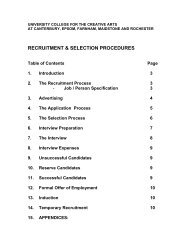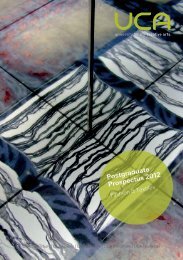John Hinchcliffe
John Hinchcliffe
John Hinchcliffe
- No tags were found...
Create successful ePaper yourself
Turn your PDF publications into a flip-book with our unique Google optimized e-Paper software.
1976. Caiger-Smith’s Aldermaston pottery in Berkshire produced domesticpottery from a small workshop of six or seven potters, and had some similaritieswith <strong>Hinchcliffe</strong> and Barber’s second studio. (The Aldermaston pottery didnot seek, for example to work with a larger commercial partner). Caiger-Smith commented on the challenge that the Dorset makers were forcefullyto address:‘...it seems to me that it would be desirable from both logical and commercialpoints of view to enter into some contract with a larger producer, who wouldsay, “You have something you can’t make enough of, I have surplus spacewhere I could increase my range. Let me make some of these things, andperhaps pay you a small royalty”. In theory, it sounds absolutely logical andeasy, but in practice it is very difficult to find a larger producer who is willingand sufficiently adaptable’. 28These matters were also being addressed by other design partnerships, notablyQueensberry Hunt, who ‘deliberately sought to prove that good design andmass market appeal are not irreconcilable concepts’. 29 Queensberry Huntworked mostly for ceramic companies outside the UK, finding that the Britishceramic industry had become so centralised that it was smaller, independentmakers who were more likely to take an experimental approach to design. 30<strong>Hinchcliffe</strong> wanted the second studio of the partnership to observe thedivision between industrial ceramics and studio ceramics and create newideas to bridge the gap, and to do so without compromise in terms of designand quality.<strong>Hinchcliffe</strong> and Barber sought to find a way that was still creativelystimulating to marry mass production (speed and quantity) with the best ofthe artistic insight (individuality and a clear visual identity). They laid downa philosophy for the creative and production base somewhere in between theconventional potter’s studio and an industrial design workshop. The newstudio was ideally placed to open up new markets and to feed larger networksof distribution and supply.18 See Diane Sheehan and Susan Tebby, Ann Sutton (Crafts Council in association with Lund Humphries, 2003), p. 115.19 Quoted in Leslie Geddes-Brown, ‘A rich palette’, Homes and Gardens, (May 1995), p. 29. In actual fact, they had seensmall scale potteries in Deruta rather than Cortona.20 Quoted in Audrey Slaughter, ‘Cottage capitalists’, Telegraph Sunday Magazine, 53.21 Tom Singh opened New Look’s first store in Taunton, Somerset in 1969. By 1994 New Look had 200 stores, and was amajor fashion retailer in the UK.22 Pictures of the house, studio and gardens are to be seen in: Suzanne Askham, Country homes and interiors, (August1986), pp. 78-83. The photographs are by George Wright.23 Sales brochure <strong>Hinchcliffe</strong> and Barber, based at 5 Town Farm Workshop, Dean Lane, Sixpenny Handley, described asbeing in ‘the heart of Dorset’. The village is in the county of Dorset but has a postal address in Salisbury, Wiltshire.24 Harriet Barber forged a notable career as a landscape and portrait painter, specialising in oils of Dorset, Cornwall andNormandy. See www.harrietbarber.com25 Emmanuel Cooper, Ten thousand years of pottery (British Museum Press, 2000) p.318. ‘A collaboration with textiledesigner <strong>John</strong> <strong>Hinchcliffe</strong> pushed her ideas forward so that large, flat press-moulded dishes and large open bowlsprovided clear surfaces for experiments with colour and pattern’.26 See <strong>John</strong> Tchalenko and Oliver Watson, Janice Tchalenko: ceramics in studio (Bellew Publishing, 1992).27 Tchalenko and Watson, p. 29.28 Elisabeth Cameron and Philippa Lewis, Potters on pottery (Evans Brothers Limited, 1976), p. 46.29 Susannah Walker, Queensberry Hunt: creativity and industry (Fourth Estate, 1992) p. 7.30 ‘The few independent potteries which did survive faced a considerable struggle and became less and less able orwilling to invest in risky modern design’. Walker, p. 34.24 J o h n H i n c h c l i f f e J o h n H i n c h c l i f f e 25
















